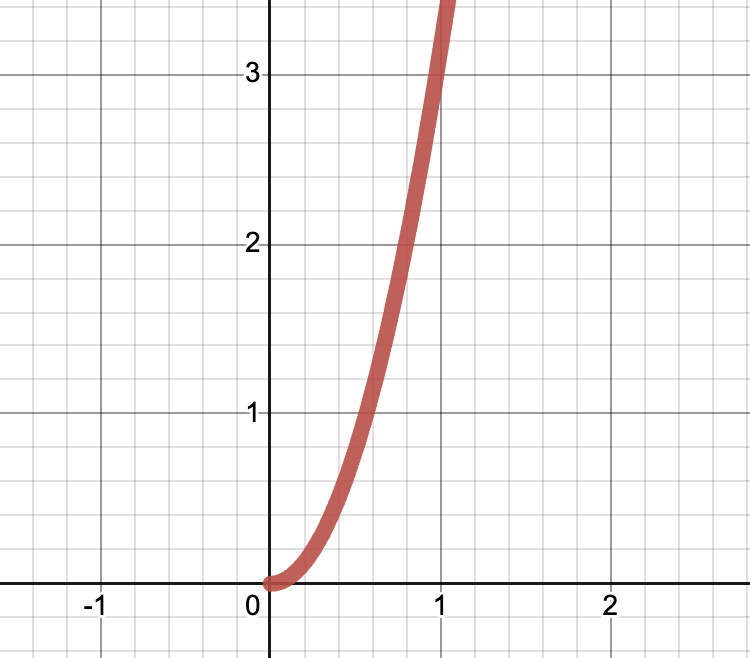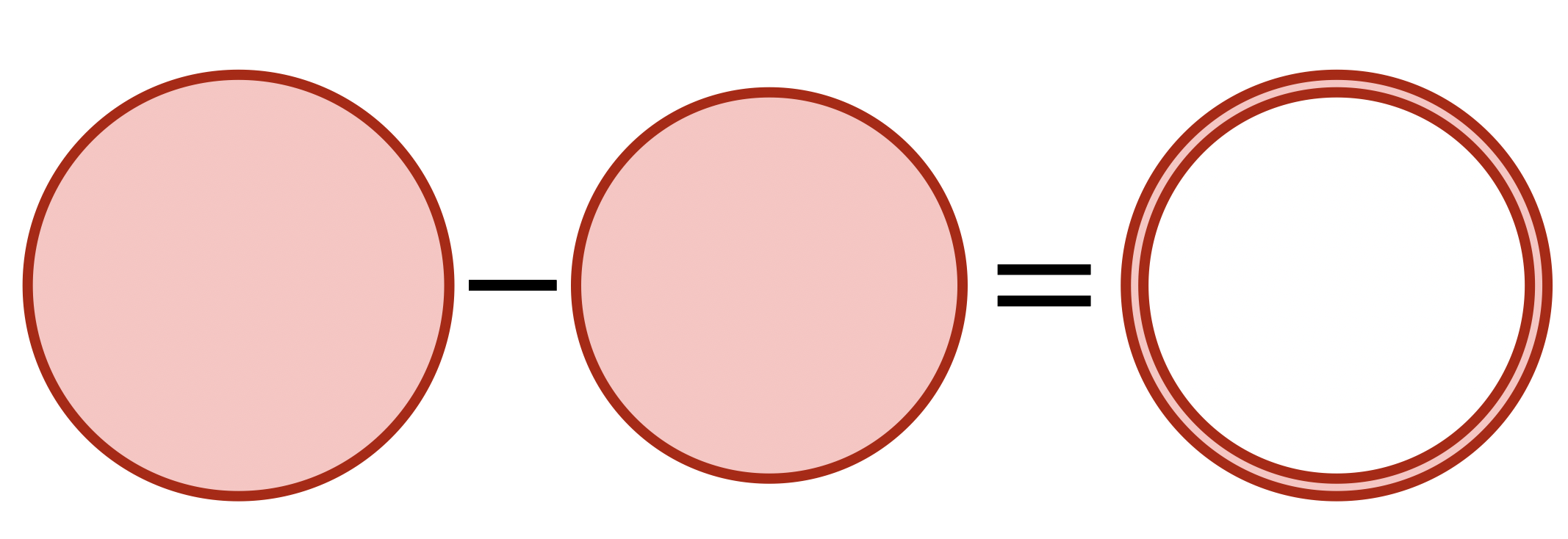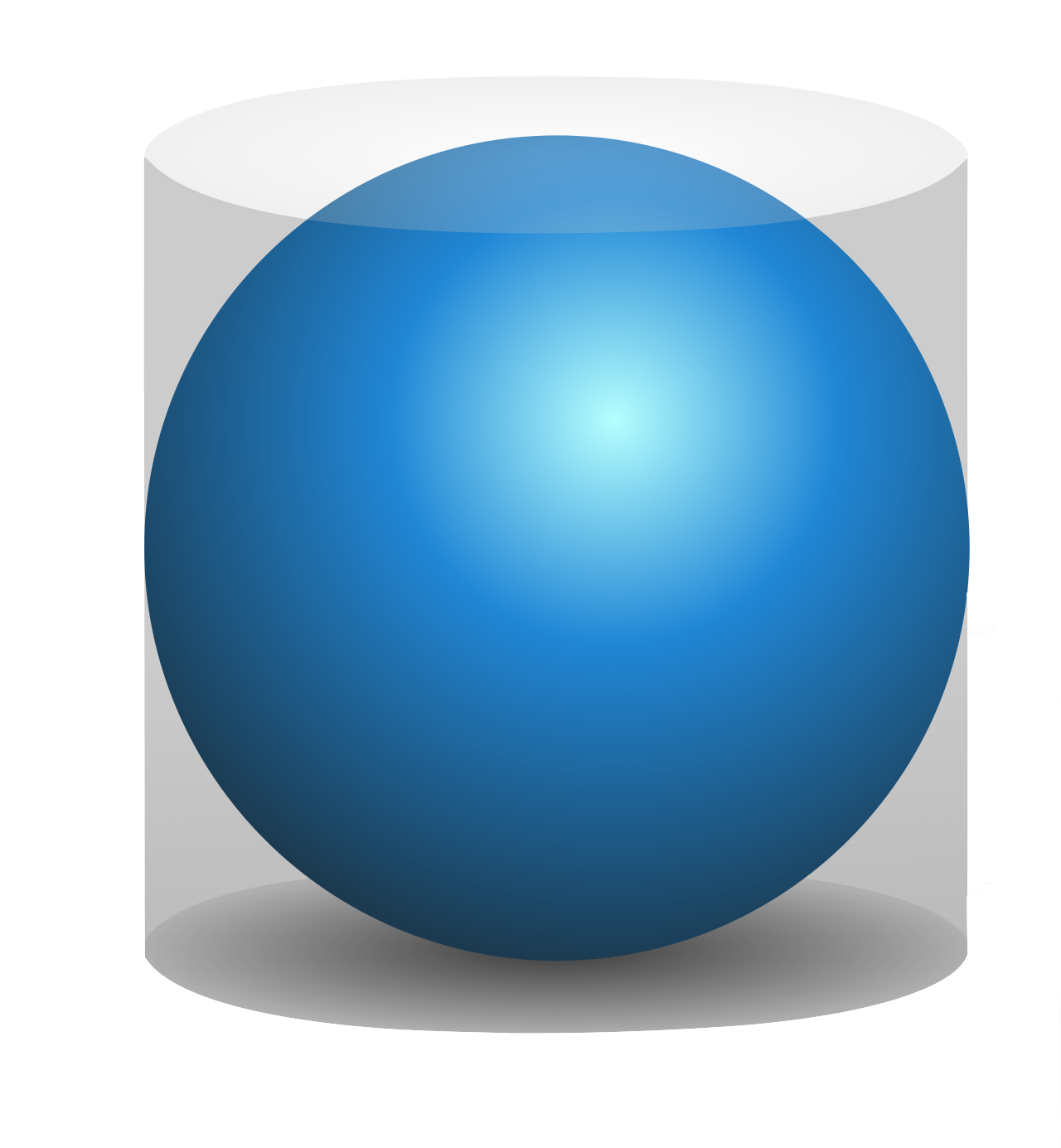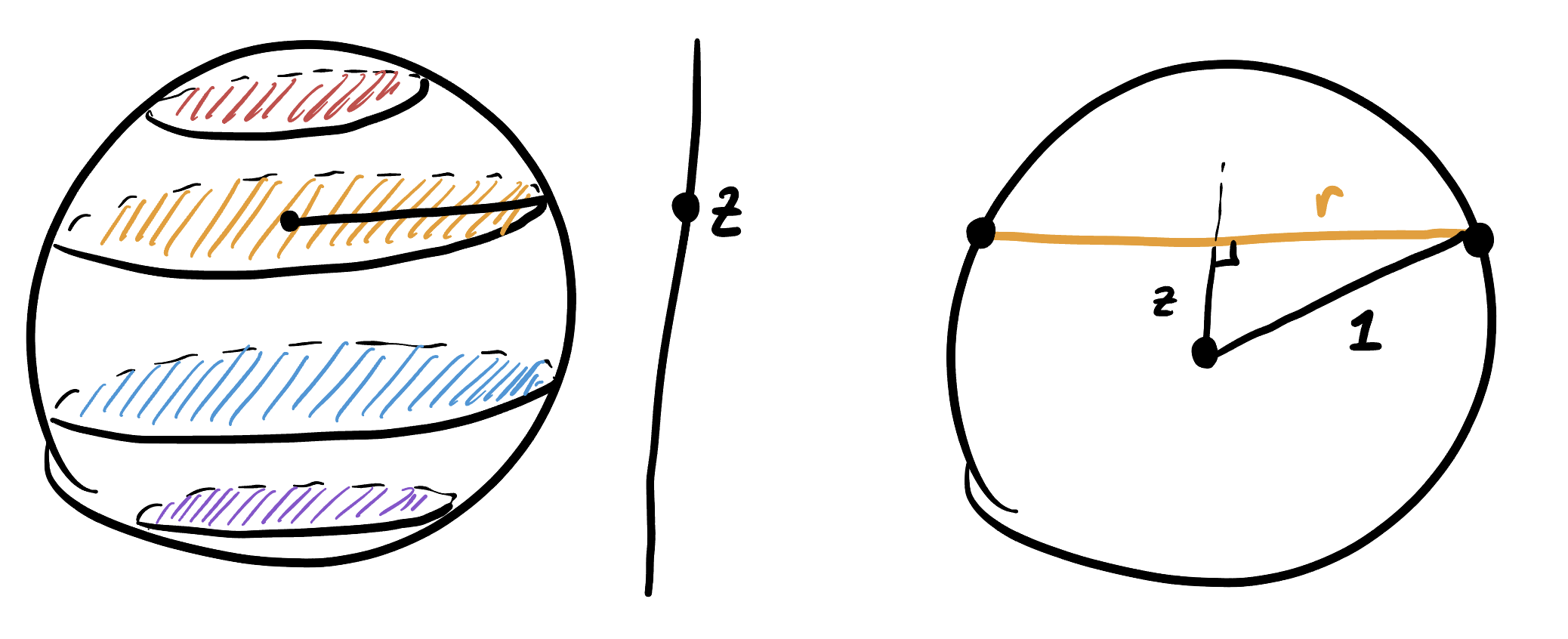16
One of the great mysteries of mathematics is the ubiquity of certain particular numbers. It scarcely matters what field of mathematics you are working in, if you think hard enough and dig deep enoughs you’ll inevitably run into the mysterious number
apearing in your calculations. (This will even happen to us, in this class, not too far from now!) This number appears in everything from finance to probability, to differential equations, group theory, real analysis, and non-euclidean geometry. But this is not even the craziest of the numerical conspiracies: the true king of almost magically ubiquitous numbers is
We have already met this number in this class, but our brief encounter (as the area of the unit circle) does not provide much evidence or intution for why this should appear everywhere in mathematics! That is the goal of this chapter: we will see that a collection of rather remarkable properties of Euclidean space make it so that many conceptually-different mathematical quantities are all (1) constant and (2) have values directly related to
16.1 Circle Constants
16.1.1 The Length Constant
For any circle
If we write

We use the letter
Both the numerator and denominator of this definition depend on the circle
But, as an incredible consequence of the existence of isometries and similarities of the Euclidean plane, it turns out that here this number is a constant!
Theorem 16.1 (Length Factor is Constant) The ratio of a circles circumference to its radius is a constant, independent of the circle.
Proof. Let
Isometries also do not change the lengths of curves (Theorem 11.2), so we know that
Now we will show that
Stringing all the equalities together, we see
Thus every circle has the same length factor as the unit circle, so the length factor is constant.
Definition 16.1 (The Circle Length Constant) The constant ratio of the circumference to the radius of a circle to its radius is
Thus in any mathematical problem involving a circle’s length, the number
16.1.2 The Area Constant
We’ve found that similarites force the length factor of circles to be a constant - and this explains at least some occurences of a geometric constant appearing in mathematics. But lengths aren’t the only important quantity related to circles out there! It’s equally natural to consider their area.
Here it doesn’t make sense to measure a circles area in units of radii, since radii are a length and area is….not a length. Instead its more natural to measure area in units of radii squared: how many squares with side length the radius does it take to fill up a circle? For a given circle

We use the letter
Again, this fraction involves quantities related to the particular circle
But perhaps after seeing the crucial role of similarities in the argument for the constancy of
Theorem 16.2 (Area Factor is Constant) The ratio of a circle’s area to its radius squared is constant, independent of the circle
Proof. The proof here is nearly identical to the length factor case, except we need to use the fact that similarites scale area by the square of their similarity factor (Theorem 15.3), instead of the fact that they linearly scale length.
Again since isometries don’t change distances or areas we can move an arbitrary circle
Next we see that
Stringing these together we see that every circle’s area ratio is the same!
Definition 16.2 For any circle
This tells us that we should expect yet another constant to be popping up throughout mathematics: anytime a discussion of circles and their areas show up, we will run into
Archimedes could have went on to estimate the value of
Exercise 16.1 (
However, Archimedes did not do this…he did something much more clever.
16.1.3 Equality
Alone these two facts don’t point towards a single, unified constnat showing up in mathematics, rather they suggest we should be seeing two different values,
It was already known to Euclid that these two constants exist: in CITE PROP Euclid shows the circumference of a circle is always proportional to its radius, and in CITE PROP he shows the area is always proportional to the radius squared. But it wasn’t until the work of Archimedes that we discovered the truly astounding fact that these two constants are related to one another! Recall the main result of the measurement of the circle
Theorem 16.3 The area of a circle is equal to that of a triangle whose base is the circle’s circumference, and whose height is the circles radius.

Because we know the area of a triangle to be half its base times its height, this tells us that
Or, cancelling the factors of
That is, the two circle constants are just integer multiples of one another! This means whether we are interested in lengths or areas, so long as we are doing mathematics that invovles a circle this constant is going to appear. (This also explains why you see so many formulas with a
As we have been doing throughout this section of the book, a good exercise is to prove archimedes observation using modern techiques. We will give two approaches here, one based on integration, and another on differentiation.
16.1.3.1 Integration
Both lengths and areas in our modern version of geometry are calculated via integrals, so it’s no surprise that the values of
And, from the area chapter (Corollary 15.1) we saw we can express its area as
In this homework excercise we will use familiar calculus techniques (just u-substitution!) to relate these integrals to one another (without evaluating either!) giving a modern proof of Archimedes’ theorem.
Exercise 16.2 Prove that
Hint: Do
Rewrite the area integrand
Now we just have to evaluate this new integral: Do the
Now just assemble the pieces! You never completed a single integral, but you still managed to prove that
16.1.3.2 Differentiation
To give a third proof of this fundamental equality, we will start wtih the formula defining the area of a circle of radius

Let’s think a bit about the derivative of this function: this is easy to compute by hand
but what does it mean? For this, we need to return all the way to the fundamentals, and think about the definition of the derivative. To unclutter the notation, below I am going to write
The numerator here is a difference of areas - between the area of a disk with radius

What’s the area of this ring? In the limit as
With this approximation becoming exact as
This is an incredibly cool fact: so we should box it off as a theorem for future reference!
Theorem 16.4 The derivative of the area function for circles of radius
But now we are all but complete with our third way of proving
And, canceling the
16.1.4 Trigonometric Substitution
The intimate relationship between
Here, we will focus directly on the area integral of Corollary 15.1,
and try to directly evaluate it via the fundamental theorem of calculus (finding an antiderivative, and plugging in the endpoints). To do a little pre-emptive simplifcation, we may notice that the integrand is an even function of
Now, we perform a rather clever substitution to the integral. Because we rigorously studied the trigonometric functions we recall that
Thus,
The last portion of the integral we need to convert are the bounds. The lower bound of
It appears we aren’t doing much better: we didn’t know the antiderivative of
Indeed, from the angle sum identity we derived,
by setting
Exercise 16.3 Derive this identity.
This lets us rewrite our integral
The first of these integrals is straightforward: its
But now - finally - we know the antiderivative! Since the derivative of sine is cosine, we can compute
All that work for zero!! But, putting it all together, we see
And going back to the very beginning we recall that
Our fourth independent derivation that
16.2 Sphere Constants
To talk about things in spheres and cylinders rigorously, we neeed to study a bit of 3-dimensional Euclidean geometry. We will return to this in more detail later in the course, but here we only give a slight taste, as it is important to our overall discussion of
Just as a circle was the set of points a fixed distance (the radius) from a fixed point (the center), a sphere is defined just as a circle except now in three dimenions. We found the equations for distance minimizing curves in 2D to be affine, and that let us find the distance formula
And consequently, the sphere centered at
The surface area of the sphere is defined exactly as we have done in the plane, by dividing its surface into infinitesimal parallelograms
16.2.1 Fundamental Constants
Let
Theorem 16.5 (Surface Area Ratio is Constant) The ratio
Proof. The proof strategy here is exactly analogous to what we did for the length and area constants of a circle: we prove that every sphere has the same surface area ratio by using isometries and similarities to relate it to the unit sphere. First, we translate
Theorem 16.6 (Volume Ratio is Constant) The ratio
Proof. Run the same proof as above, but now notice that when we scale volume, infinitesimal volume is measured by
Just as we gave names
16.2.2 Relationship to
The work Archimedes was most proud of we have barely discussed yet in this class. In his book The Sphere and the Cylinder, Archimedes managed to find a relationship between the formulas for the surface area and volume of a sphere, and relate them to those of a cylinder. This was of course a big deal because the volume of a shape with curved sides had never been caclulated before, but it was an even bigger deal the form that the answer took. Specifically, Archimedes found that for surface area, the area of the sphere is exactly equal to the area of the round side of a the smallest cylinder that can enclose it (whose radius is the same as the spheres, and whose height is the sphere’s diameter)

In modern notation, we would write this relationship with a formula. A cylinder is a rolled up rectangle, and so we can calculate its area with base times height. The base is the circumference of the cylinder (so,
Because we already proved
This tells us immediately the value of the surface area constant, as its definition is just the surface area over
Theorem 16.7 (Value of the Surface Area Constant)
We will prove this using modern tools below, but I’ll postpone the proof until we talk about Archimedes other great discovery - calculating the volume of a sphere.
Through an ingenious argument by slicing, Archimedes showed that the volume of the sphere is the same as the volume of the following complicated sounding shape: the volume in between the cylinder enclosing the sphere (from above), and the double cone that fits inside it:

Archimedes original argument was by slicing: he imagined slicing each of these shapes by a plane at different heights, and he showed that at any given height
Exercise 16.4 Confirm Archimedes claim: show the slice of a sphere and cylinder-minus-cone at height
Then Archimedes noted that the volume of a region is the integral of the area of its slices (of course, not using these words, as they were not to be invented for another 1800 years!) and so two shapes with all the same cross sectional areas must have the same volumes.
He next computed the volume of a cylinder to be the area of its base times its height, and the area of a cone to be
But this immediately gives us the value of the sphere volume constant in terms of
Theorem 16.8 (Value of the Volume Constant)
Archimedes found this fact so striking and so beautiful that he asked for a Sphere and a Cylinder (the key ideas in this proof) to be engraved on his tombstone. As far as we can tell in the historical record, his wish was heeded when he died in 212BCE- but his grave was quickly forgotten to those living on his native island of Syracruse.
However, in 75BCE, the great Roman orator Cicero was visiting Syracruse and searched out Archimedes - then already known as the greatest mathematical mind in history, and found it due to this carving. In his own words:
“Once, while I was superintendent in Syracuse, I brought out from the dust Archimedes, a distinguished citizen of that city. In fact, I searched for his tomb, ignored by the Syracusans, surrounded on all sides and covered with brambles and weeds. The Syracusan denied absolutely that it existed, but I possessed the senari verses written on his tomb, according to which on top of the tomb of Archimedes a sphere with a cylinder had been placed. But I was examining everything with the eyes … And shortly after I noticed a small hill not far emerged from the bushes. On it there was the figure of a sphere and a cylinder. And I said immediately to the Syracusans “That’s what I wanted!” > Cicero, 75 BCE
16.2.3 Modern Computation
Having seen the beauty of the results which we are after, we will now seek to prove them with modern (calculus-based) methods. We find the volume of the sphere by slicing into disks, and we know the area of a disk from slicing it into line segments!

Because we know the number we are after is constant we are welcome to work directly with the unit sphere so that extra letters like radii don’t complicate our lives. Call this sphere
Where
All that remains is to figure out the radius of the slice at height

Alternatively we may just do this algebraically, and note that if
Now plugging this into the area-of-a-disk formula, we can continue our integration by slicing:
Because a homothety multiplies each infinitesimal length by its scaling factor, it increases the infinitesimal volume by the cube of the scaling factor. Thus, scaling up from the unit sphere to a sphere of radius
Now, we can apply everything we learned thinking about circles to give a quick modern derivation of the area constant: area is the derivative of volume!
PICTURE
The reasoning goes through exactly analogously here: the difference quotient
16.3 Higher Dimenisons
What about the fourth dimension? Can we fiigure out how spheres work there? The fact that lines are given by affine eqautions holds true in all dimensions, which allows us to write down the distance formula in
To keep things simple we can start again with the 4-dimensional unit sphere, which is described by
Let’s call this sphere
It’s going to get difficult to keep dimensions straight here, so I’m going to start subscripting our volumes: I’ll write
This leaves us once again with a single integral to do! And all we need is the relationship between the radius
In theory, all we have to do now is plug this in and integrate! In practice this integral is a bit more challenging than we have come across before (though nothing that you haven’t seen already in a Calculus II course)
This integral requires a trigonometric substitution to complete. It’s perhaps easier to deal with the bounds if we first realize the integral is an even function, and so we could instead just integrate on
Now we can make the substitution
Now we have yet more work, as we have arrived at the integral of the fourth power of cosine. This requires some trigonometric work with the double/half angle identites we proved:
Exercise 16.5 (Integrating
Then use this to confirm that
Putting this together with the above, we finally reach our answer (using that
This is the first time that our constant has not been a rational multiple of
Theorem 16.9 (Volume of the Hypersphere) The volume of the 4-dimensional hypersphere of radius
From this we can get the three dimensional surface area by differentiation. Again to keep things straight, I’ll write
Theorem 16.10 (Surface of the Hypersphere)
Thus, the 3-dimensional surface area constant for hyperspheres is
Exercise 16.6 Find the volume and surface area constants for the 5-dimensional sphere via integration by slicing (for volume) and then differentiation (for surface area).
16.4 A Surprise in Even Dimensions
If you complete Exercise 16.6 above, you’ll find that the 5-volume has a rather strange-looking constant out front:
What can we do with this information? Carry on the march to higher dimensions of course! If we try to find the volume of the unit 6-sphere by slicing, (say the axis we slice along is called
Unfortunately this time (again!) we cannot get rid of the square root since
Now we need only expand out
Exercise 16.7 Confirm, similarly to a previous exericse that
And thus, that the definite integral we are after is
Plugging this back into our original expression we get some almost magical cancellation of all these constants:
Theorem 16.11 (Volume of the 6-Sphere) The volume of the six dimensional sphere of radius
From here - if we were feeling brave - we could calculate the volume of the seven-dimensional ball by slicing (which would not need a trig sub, as the slices are 6 dimensional and the sixth power will get rid of the square root) yeilding
Then use this to calculate the volume of the 8-dimensional ball by slicing (which will now need another trig sub, which will introduce another factor of
A pretty interesting pattern is arising here - using
It appears that the volume of the
Theorem 16.12 (Even volumes)
One way to prove this is to continue the process we have been doing, with the trig subs and all, but via induction (and being clever, realizing we only need to know the constant term of
But there’s an alternative way - one can try to integrate via slicing over two dimensions at once, and get a recurrence relation relating the volume in dimension
Proposition 16.1
If you’re interested in doing this - come talk to me in office hours! But now for the truly strange part: what is the sum of the volumes of all the even dimensional balls?
WHAT?! This is the series expasion of
Why in the world is the sum of the volume of all the even dimensional balls what you get by plugging the area of the circle into the exponential function?! I have no idea…